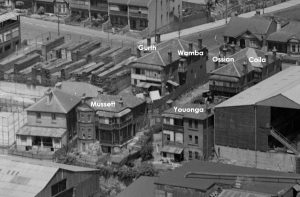
By Rodney Hammett, Bulletin 5/2024, July
This is the second part of a story on the six dwellings on the site of the current Anchorage development at 451 Glebe Point Road. It is an account of a few of the many families who lived in Gurth, Wamba and Mussett from 1887 to 1930 (Table 1). As discussed in Part 1, the dwellings were owned and built by Robert Buik Edward, so these families were tenants. If you’d like to read the first part of Gone and Forgotten on Glebe Point Road.
Gurth
The first occupants were Charles and Sarah Parish and their son Walter. Charles had been a plasterer, and had married Sarah Severn on 31 March 1845 in the Sydney Parish of St Lawrence, most likely at the church now known as Christ Church St Laurence, which had been consecrated that year. Charles was aged 33 and Sarah, 22.
Charles and Sarah went on to have a family of six boys and two girls while Charles worked in and close to the city. The first seven children were born in Sydney but their youngest Walter was born in Brisbane in 1865. Here in 1862, Charles became the licensee of a Spring Hill hotel, which he built into such a successful business that years later, it was still referred to as ‘Parish’s Hotel’. The family returned to Sydney in the early 1880s and moved into the newly built Gurth in 1887. Charles’ stay at Gurth was very short, as he died there on 11 June 1887, aged 76. Sarah stayed on for a year then moved to the lower North Shore where she died in 1906 aged 84. After serving as an articled clerk, son Walter was admitted as a solicitor in May 1887. Walter married Rosend Eugene Samper at Summer Hill on 27 March 1889. They had two sons and lived in Mosman where Walter died of bronchitis in 1939 aged 74.
Charles Clark and his wife Jane Eliza (born Cox) were newlyweds when they moved into Gurth in late 1888. They had married in Victoria in 1888, aged 43 and 38 respectively.
Charles and Jane both heralded from pioneering families in Hobart, Tasmania. Their first child, Phyllis, was born at Gurth on 9 December 1888 and was baptised on 27 January 1889 at St John’s Church in Glebe. Charles was a law clerk and the family lived at Gurth for eight years. A son, Charles William, was born at Gurth on 23 March 1890. From Glebe, the family moved to Melbourne, where in August 1902, Phyllis tragically died, aged only 13. The family then returned to Hobart, but soon after, Charles died of a heart attack on 24 June 1907 aged 62. In an obituary in the local paper, Charles was remembered as a well-known and popular fellow, and a decent vocalist who participated in many concerts during the 1860s and 1870s. Jane died in 1927 at the age of 77.
Richard William Sheehy, aged 41, moved into Gurth in 1905 with his wife Katherine. They had married in 1903, at which time Katherine’s family name was given as Crimmins. Their daughter Mary Margaret Sheehy had been born in Avon Street Glebe in 1904 where the family had previously lived. Richard was a shipwright who, with his brothers Daniel, Michael and Simon and father Daniel (1835–1906), conducted a successful lighterage and general marine contracting business under the name of D Sheehy and Sons on Sydney Harbour from wharves at Glebe and Greenwich.
The firm often secured contracts to raise damaged vessels within the harbour. One such contract was for the harbour steamer Princess (Figure 1), which had sunk at Circular Quay in December 1897 following a collision with the North Shore steamer Cammeray. In January 1898, a new sight for Glebe residents was the Princess on the mud of the Glebe foreshore in Blackwattle Bay, awaiting repairs. Daniel junior died in 1903. Michael died in 1905.
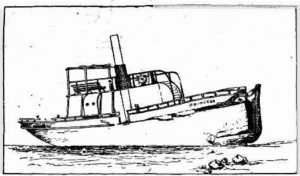
When Richard and Katherine relocated to the North Shore in 1907, Richard’s brother Simon Sheehy moved into Gurth with his wife Clemence and their five children, four girls and one boy. Another girl was born in 1907. Despite Simon being four years younger than Richard, Simon was married in 1894 to Clemence Clasen, whose father was a master mariner from Holland. Simon and his family lived in Gurth until 1909 when they moved to the lower North Shore and eventually to the final family home in Greenwich.
Richard, Katherine and family returned to Glebe where they lived between 1914 and 1918 at 11 Allen Street. They then moved to Manly where Richard lived until he died on 2 February 1936, aged 72. His estate was valued at just over £17,568 for probate. Katherine died on 23 August 1949, aged 80.
The story of the Sheehy family in Glebe, including the naming of Sheehy Street and the firm D Sheehy & Sons, is too long to be included in this article, so look for it in a future Bulletin.
Robert B Edward and family also made Gurth their home when Robert returned to Glebe in 1910 following his retirement as postmaster of the William Street Darlinghurst post office (see Bulletin 3/2024 for further details). Robert, his second wife (his first wife, also Mary, died 1896 aged 44) Mary and daughters from his first marriage, Jessie and Mary, lived in Gurth until 1912 when they moved into nearby Mussett where they remained until 1924. Robert’s daughter Mary married Thomas Ralph Coulson on 22 March 1917, after which the couple moved to the Gosford area where Thomas had a farm.

A photo of the Edward family (Figure 2) was given to Genny Kang by a member of the Coulson family when the research for the Eglinton Road Project was underway in 2011. The two women and the man seated in the middle-ground are members of the Edward family – most likely daughters Jessie and Mary with their father, Robert. Examining this photo and the 1940s aerial photo (Figure 7) has established that the building on the right in the photo is Youonga, and the building partially visible on the left is Mussett. The access ramp and the grass area in the foreground are likely to be the common ground shared by Mussett and Youonga. The photo, taken in the 1910s, shows the grandeur of the buildings and the residential use of the waterfront before it was taken over by the timber industry.
Wamba
Julius Emanuel Buddee (1856–1923), his wife Lilia May (born Peters) (1867–1943) and their almost-two-year-old son Thomas Richards Buddee moved into Wamba in late 1887. Three years later, daughter Charlotte was born at Wamba on 27 April 1890.
Julius Emanuel Buddee was the fifth of eleven children of talented pianist German-born Julius Friedrich Wilhelm Buddee (1823–1890) and Elise Buddee (born Schroedor) (1823–1898). Julius senior and Elise married in Berlin in 1846, and in 1849, along with their first-born son, travelled to Victoria during the gold rush. Sadly, the son died on the voyage. Despite Julius senior’s acclaim in Melbourne as a pianist and music professor, his health was poor, and on the advice of his doctor in the mid-1850s, he and his family moved to Hobart. In about 1862, having regained his health, Julius senior returned to Melbourne with his family, where they settled down to a comfortable life until his health again took a turn for the worse, and they relocated to Sydney in 1884. Julius Buddee senior’s professional life continued with great success in Sydney. He and Elise lived in Glebe at several addresses in Toxteth Road and Boyce Street, before he died aged 67 at Cremona, 28 Boyce Street, in September 1890.
Julius Emanuel Buddee, the son of Julius senior, moved into Wamba in late 1887 before leaving for Leichhardt in late 1890 and then Perth. Julius junior worked as a law clerk in Sydney and was appointed a clerk of the Supreme Court of Western Australia in September 1900. He and Lilia had twelve children between 1886 and 1912. Julius junior died suddenly at home in Perth on 19 February 1923 aged 66; four of his children predeceased him. Lilia died in 1943 aged 76.
Charles Stanley Abrahall moved into Wamba in 1895. He had arrived from London on the Orient Line ship Orizaba on 26 October 1891. Several years before emigrating, 20-year-old Charles married 18-year-old Ada Pasby in 1885. This was not a successful union, and Charles left for Australia after instigating divorce proceedings in 1890 on the grounds of her adultery, an allegation eventually found to be false.
Having arrived in Australia, Charles quickly established a jewellery business in Sydney (his family had a wholesale jewellery business in Alston, Warwickshire). However, Charles was declared bankrupt in December 1891, when he was living at 22 Avon Street Glebe. His circumstances must have taken a turn for the better by 1895, as he was able to move to Wamba that year.
In 1899, advertisements appeared announcing C S Abrahall as the manager of the Sheffield Manufacturing and Plating Company’s Australian branch at 309 Pitt Street, Sydney. Where he was living at this time is unclear; although he may have remained at Wamba until 1901 renting a room from John Lord, then followed the Lord family to Youonga in 1902, again renting a room. Charles died on 13 December 1907 at the age of 44. His funeral notice stated that the funeral would leave from the residence of his friend John Lord at Youonga Glebe Point.
John Lord, born John Stone Lord in Sydney in 1860, married Mary Ann Oliver in 1882. They had two children – Rosemond born in 1883 and John Stone William born in 1888. So it was a family of four which moved into Wamba in 1896. John senior was a broker and from a large Catholic family with many connections to Glebe. Passionate about rugby, John was the president of the Glebe Rugby Union Club for several years during the sport’s heyday (1900–1914) and one of the leaders in surf lifesaving in Sydney. The family lived in Wamba from 1896 to 1901 and nearby in Youonga from 1902 to 1908. After this, they moved to Manly.
John Stone William Lord, son of John Lord from the previous paragraph, became a mechanical engineer working at the CSR sugar refinery at Pyrmont. Following the outbreak of World War One, he enlisted in the Australian Army on 22 August 1914 and was part of the reinforcements sent to the Gallipoli Peninsula in April 1915. Lucky to survive, and following a short hospital stay, John Lord junior transferred to the 1st Light Horse Regiment in Egypt in January 1916. Then, in November of the same year, he joined the Australian Flying Corps, known as Squadron 68 RAF.

While in England working for Australian Flying Corps as a fitter in the maintenance team, he requested to train as a flying officer in July 1917. He completed the training by January 1918, becoming 2nd Lieutenant J S W Lord. It was during a training flight in a DH 5 over Worthy Down Winchester on 12 May 1918 that the aircraft crashed, and John was killed (see Figure 3). He was buried with military honours on 15 May in the All Saints Churchyard, Hursley. He was 29 years old.
John Lord senior died on 30 December 1933 aged 73, without making a will. His Letters of Administration show that his estate was valued at £38. Mary Ann survived him by eight years, dying in 1942 aged 80. Rosemond married Frederick (‘Freddy’) Claude Vivian Lane at St Mark’s Darling Point on 14 September 1908. Freddy was Australia’s first Olympic swimmer and a world class athlete. At Paris in 1900, Freddy won gold in the 200 m freestyle and 200 m obstacle race. Rosemond and Freddy lived on the northern beaches where Rosemond died in 1957 aged 74.

Charles Moffitt (1843–1918) (Figure 4) was aged 66 when he arrived at Wamba in 1909 with his wife Mary (born Mitchell) (1845–1929), who was aged 64. Charles was a well-known figure in the mining industry, having learnt the lure of gold from his father who had tried his luck at the Victorian goldfields in the 1850s. Charles had made a fortune – and lost it, too. He lived in Glebe for a few years (1909 to 1911) while he reassessed his next venture(s).
Charles was born near Dungog in the Hunter Valley on 16 January 1843 to Irish-born parents Charles (1812–1873) and Annis (born Elliott) (1812–1900). It is unknown how many siblings Charles had, but he did have a younger brother William and younger sister Mary. The family moved from the Hunter Valley to the Shoalhaven area in 1846. In the early 1860s, Charles and his brother William had some success with alluvial gold, but they subsequently drove cattle to and from Goulburn and Bathurst.
In 1875, Charles married Mary Mitchell of Sutton Forest. Eight children came from this marriage: Mary (1875–1951), Herbert (1877–1953), Ada (1879–1946), Charles (1880–1957), Arthur (1883–1971), Beatrice (1885–1960), Sidney (1887–1950) and Theodore (1889–1892). One cannot question their upbringing because Herbert went on to become a judge, Charles became a school teacher, Arthur became a dealer and Sidney became a bank manager.
When Charles died at Towrang near Goulburn in 1918 at the age of 75, an obituary in the Shoalhaven Telegraph of 3 April 1918 included, ‘He had a strong personality, and even though he had received scant education in his boyhood, he was well versed in politics, and in the laws of his own State pertaining to pastoral and mining pursuits. He was a good impromptu speaker, a quaint humourist, and his ability to tell a good yarn was universally recognised.’ Not to be outdone by her husband’s stories, Mary could recount the times before her marriage when her family were robbed by bushrangers in the 1850s and 1860s. She had also been a skilful horsewoman. Mary died in Queensland in 1929 aged 84.
Mussett
Alexander Victor Augustus Bulteau arrived in Sydney from France in February 1882 in search of the type of employment he considered appropriate to his station in life. In addition to advertising his skills and attributes to prospective Sydney clientele, he placed newspaper advertisements aimed at Queensland squatters (see Figure 5).
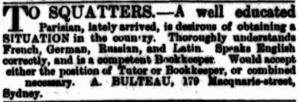
By 1884, Alexander was on the King’s School Parramatta staff teaching modern languages. He was also the French Master at Kingsley College, a ‘High-Class School for Girls’ in Burwood. By 1885, he was a lecturer in French at the University of Sydney. Monsieur Bulteau, as he was known, married Irish-born Mary Sullivan at the Unitarian Church in Liverpool, Sydney on 14 August 1886. At the birth of their first child, a son, on 20 October 1887, the family was living at what is now either 425 or 427 Glebe Point Road. Their second child Alfred William was born on 17 July 1890 at the newly completed Mussett, the same year the family moved there.
What prompted their move to Trusthorp in Boyce Street Glebe by the time their third son was born in April 1892 is something we will never know. Was the house too big and the rent too costly? Was access down the stairs from Glebe Point Road too difficult with three young children? Was living beside an active harbour with all its noise and smells not what the family wanted? Or had the family’s circumstances changed? Monsieur Bulteau was in 1892 advertising for French students and stating he was ‘late Lecturer and Examiner, Syd Univ.’
Monsieur Bulteau must have been troubled because he ended his life at the Gap on Monday 30 January 1911. The Coroner’s report said Bulteau gave no indication that this was his intention when he left his Gordon home that morning. Somehow, his wife Mary continued on without him, dying at Drummoyne in June 1937 at the advanced age of 88 years. Of the sons, Alfred William became a medical practitioner and died in 1980, and Victor Horace became the chief attendant at the Art Gallery of NSW and died in 1978. Their daughter Marie Julie was born in 1894, married a medical practitioner, and lived in Balmain until she died in 1929 at age 35. She was fondly remembered by the Balmain community for the enormous amount of charity work she undertook.
William Arnott was a solicitor, moving into Mussett in 1900 with his wife Catherine (born Thomson) and their five daughters. Another two daughters were born after they left in 1902. William, born in Islington England on 31 December 1861, was a founding partner of the law firm A J Taylor, William Arnott and Company of Hunter Street, Sydney. With an interest in horse racing, William Arnott was the Ascot Racing Club’s chairman and solicitor, and from its inception, he was the honorary solicitor of the Crown Street Women’s Hospital. William had married Irish-born Catherine Agnes Thomson on 1 June 1891 at St Mary’s Cathedral, Sydney. From Glebe, the family moved to a large house in Woollahra.
William died while he was at a Freemason’s evening at the Royal Arch Temple College Street Sydney on 26 October 1937. He was aged 75. Catherine lived to a grand age of 96, dying on 23 November 1958. The seven daughters all lived into their nineties.
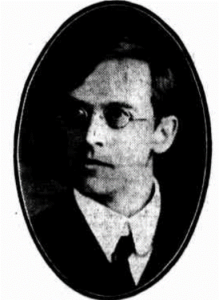
Stephen J Johnston (Figure 6) and his wife Grace Sarah (born Beach) moved into Mussett in 1908, in time for their son Philip to be born there on 7 July. Stephen was the fifth of eight children of Jason Johnston and Augusta Elizabeth (born Cross). Johnston’s maternal grandfather was a Methodist missionary (Rev William Cross) who spent much of his life in Fiji and Tonga. Augusta was born in Levuka Fiji in 1837. Stephen’s father was a Protestant from Ireland who arrived in Sydney aged nine in 1844 with his father and four siblings, his mother having died on the voyage.
Stephen was born in Sydney in 1873. A keen student, he attended the University of Sydney where he graduated with an Arts degree in 1894. He commenced a Science degree in 1902. He gained his doctorate in 1912 with a thesis, On the Trematodes of Australian Frogs, and received the University Medal. Stephen and Grace Sarah Beach married on 28 June 1901 at Dulwich Hill. They left Mussett in 1913.
The Johnstons’ son Philip died in 1909 when he was barely a year old, so Stephen’s success at the University of Sydney was tempered by this tragic loss. Stephen became a member of the Department of Zoology at the University in 1906. Not unlike today, he had to wait until the retirement of Professor Haswell in 1918 to be appointed as professor of that Department. He was then aged 45. His period as head of the Department was short-lived, however; he had fallen ill and, in 1922, had to relinquish the role and resign. Stephen died on 16 July 1925, aged 52. An obituary remarked that he possessed a genial nature and was well-liked by his students (see Figure 6).
Author’s Note: This limited exploration into the lives of a few of the families who lived in Gurth, Wamba and Mussett gives us some understanding of the diverse backgrounds and trajectories of the families who lived in Glebe during the period 1887–1930. In all probability, if we could do the same analysis for the families who currently live in Glebe and Forest Lodge, their stories would probably echo a similarly wide range of experiences.
If readers have an interest in any of the other families listed in Table 1, please contact the author.
References: Trove, newspapers; Ancestry records and family trees.
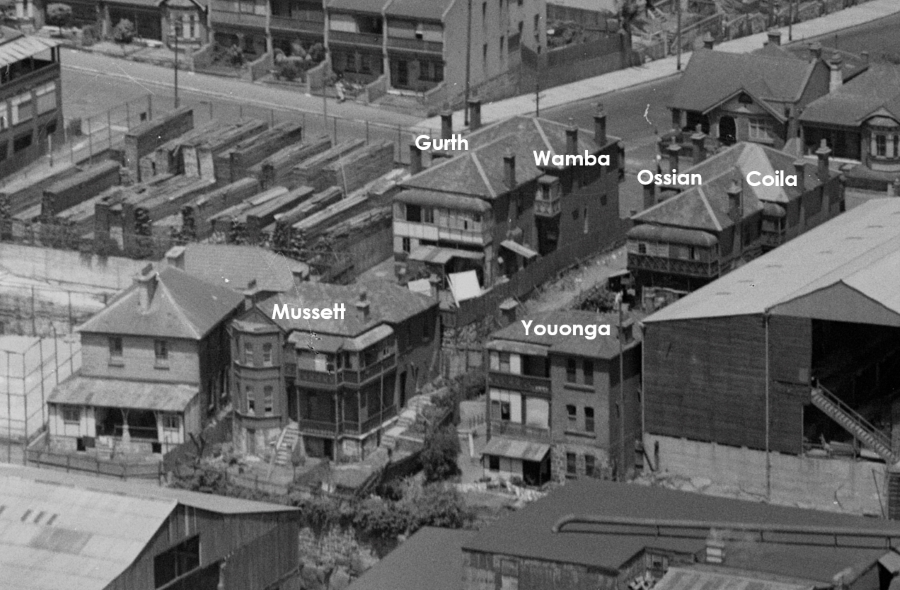









There are no comments yet. Please leave yours.